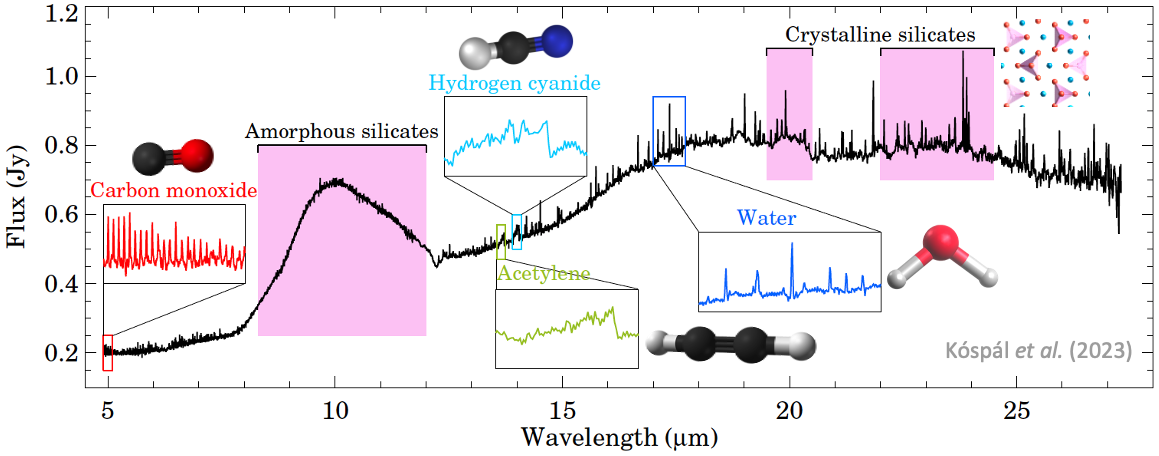An international team led by researchers from the Konkoly Observatory at the ELKH Research Centre for Astronomy and Earth Sciences (CSFK), used the MIRI spectrograph onboard the James Webb Space Telescope (JWST) to study the circumstellar disk of the Sun-like young star EX Lupi. Thanks to the exquisite sensitivity of the instrument, they rediscovered long-lost silicate crystals that had formed in an earlier outburst of EX Lupi. In the infrared spectrum of EX Lupi's disk, they also detected molecules that are essential ingredients for the development of life, among others carbon monoxide and water vapor. The crystals that formed in a hot environment have now moved to a colder part of the protoplanetary disk that encircles the star, where they may become parts of forming comets and planets. This provides a possible explanation for the high amount of crystalline grains in comets in our own solar system. A study with the results of the research was published in the Astrophysical Journal Letters.
With an age of a few million years and a mass only 60% of that of the Sun, EX Lupi is the Sun’s little sibling. It is still accreting material from its circumstellar disk, while embryos of comets and planets may be currently forming in the disk. The accretion process onto the star is not steady, but it sometimes increases by several orders of magnitude, causing an outburst that heats up the star’s environment.
During one such heating event in 2008, the lead authors of the present study witnessed, for the first time in a cosmic environment, the transformation of amorphous silicates into crystalline ones. This means that the structure of the dust grains turned from disorganized into organized. This process happened due to the heat released during the outburst in the inner disk, within 1 astronomical unit of the central star (1 astronomical unit is the average Earth-Sun distance, 150 million km). The outburst ended in late 2008, and the scientists hypothesized that the freshly formed silicate crystals started moving farther away, probably transported by the stellar or disk wind. However, for the past 15 years, astronomers did not have an instrument sensitive enough to detect the tenuous signal of the slowly cooling crystals.
Thanks to the JWST, researchers have now found evidence that the crystalline silicates created in the inner disk during the outburst in 2008 were still around in 2022, but have moved farther away from the star to about 3 astronomical units. Interestingly, this distance is close to the snowline in this system, the place where the temperature becomes low enough for water to freeze. The rediscovered crystalline grains, about which the researchers have had no information for 15 years, are now cold enough that they may acquire icy mantles. Because these grains may eventually be built into planetesimals or icy protocomets, whose most important ingredients are water ice, carbon monoxide ice, and crystalline silicates. Thus, the new data also provide a possible explanation for the high amount of crystalline grains in comets in our own solar system.
The excellent spectral resolution of the infrared spectrum of EX Lupi’s disk also allowed the scientists to identify features of various molecules such as carbon monoxide, carbon dioxide, hydrogen cyanide, acetylene, and water. When frozen, these molecules may build comets, while in gaseous form, they may contribute to the atmospheres of forming planets, and later they may even make more complex molecules vital for life through further chemical processes.
The publication containing the details of the research is led by Ágnes Kóspál, research advisor of Konkoly Observatory, whose work is supported by the European Research Council (ERC). The study was made in collaboration with researchers from institutions from Hungary, the US and Germany.

Figure 1: Illustration of the James Webb Space Telescope (Credits: Northrop Grumman)

Figure 2: Illustration the disk around the young stars EX Lupi (Credits: NASA/JPL-Caltech)

Figure: 3: The infrared spectrum of EX Lupi’s disk taken by the James Webb Space Telescope. Researchers identified signatures of solid dust grains and various gas molecules. (Credit: Kóspál et al., 2023)